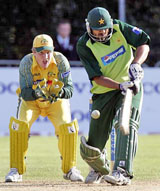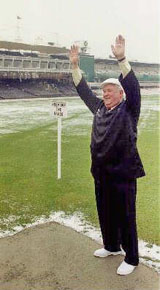ARTICLES
My best Test Series - Australia in India - 1969-70
- By Piloo Reporter
Technology entered cricket in a big way in the 1970s with Kerry Packer's World Series Cricket. Slow motion replays and freeze-frames took TV viewers closer to the action, and made an umpire's job a lot more difficult! Till then, the two umpires had to deal with 22 players, 13 of whom were on the field at any given point of time. But post-Packer, they had to contend with a battery of former Test cricketers-turned-commentators, and millions and millions of TV-watchers from across the world! Of course, these changes happened for the best, and they have contributed in no small measure to the popularity of the sport. Cricket today is as much a Television sport as it is a field sport.
My response is that it will not make much of a difference in the era of the 'front-foot' no-ball rule that began in 1964, in which the bowler releases the ball and lands his front foot almost simultaneously. Pre-1964, when the 'back-foot' rule was in vogue, the no-ball shout was heard earlier and so the batsman could go for it. However, the back-foot rule encouraged many bowlers to 'drag' their front foot well over the popping crease by six to eight inches, thereby reducing the distance from the batting crease and releasing the ball from less than 22 yards, which was unfair. Thus, every rule has its share of pros and cons.
Ideally, the earphone should be kept in abeyance unless it is 100 % foolproof. It will be interesting to see how things unfold in the Champions Trophy. I do hope that the earphone behaves itself! Having said that, I would like to compliment the ICC for their dynamic and pro-active stance in furthering cricket's relationship with technology. Some innovations will work, others may not, but that doesn't mean you should stop experimenting. As they say, "The harder you work, the luckier you get!"

Inzamam's controversial dismissal in the Holland
Tri-series final - The ball hits him on the thigh and flies to the keeper Brad Haddin
In later years, technology was brought in to assist the umpires with 'line' decisions like run-outs and stumpings, the aim being to increase the accuracy and consistency of the umpires in making decisions. Accordingly, the 'third umpire' made his debut in 1992-93, when the Indians toured South Africa. In the 1996 World Cup, the third umpire's jurisdiction was extended to 'line' decisions pertaining to the boundary. This meant that the field umpires could now check with their colleague if a particular stroke had crossed or landed just within the playing area, or if a fielder had held a catch or stopped a hit without touching the boundary rope.
The recent tri-series in Holland featured two innovations, which will also be a part of the forthcoming Champions Trophy. The first one is the third umpire tracking no-balls. The third umpire will now watch the bowler's feet and inform the field umpire on his earphone (will come to that later), if the bowler oversteps the popping crease with his front foot, or cuts the return crease with his back foot. The field umpire will then yell "no-ball". It is true that this process will slightly delay the 'no-ball' call. All those who are opposed to this innovation have been harping on precisely this point, arguing that a delayed call will give the batsman very little time in which to capitalize on an illegal delivery.
The recent tri-series in Holland featured two innovations, which will also be a part of the forthcoming Champions Trophy. The first one is the third umpire tracking no-balls. The third umpire will now watch the bowler's feet and inform the field umpire on his earphone (will come to that later), if the bowler oversteps the popping crease with his front foot, or cuts the return crease with his back foot. The field umpire will then yell "no-ball". It is true that this process will slightly delay the 'no-ball' call. All those who are opposed to this innovation have been harping on precisely this point, arguing that a delayed call will give the batsman very little time in which to capitalize on an illegal delivery.

David Shepherd -
let down by the earphone
I have always believed that the umpire at the bowler's end should be relieved from the responsibility of calling no-balls and like the striker, concentrate on the ball from the time the bowler releases it. This is far better than the existing system wherein he first watches the bowler's foot and then quickly shifts his gaze towards the ball, by which time, it has travelled a fair distance. If the umpire watches the ball from the start, he can pick variations like the googly, flipper, inswinger, etc. that will help him make correct decisions. Hence, the first innovation is a blessing for the field umpires.
The second innovation is the earphone connected to the stump-mike, which the field umpires will use to hear nicks / edges better. While I support this in theory, I am a little skeptical about the way in which it worked, or rather, did not work, in the Holland final. David Shepherd was criticized for declaring Inzamam-ul-Haq and Yousuf Youhana out caught behind. The TV replays showed that the ball had missed Inzy's bat and struck his thigh, whereas Youhana was first hit on the flap of his pad and then his thigh. However, it won't be fair to blame David, as he was clearly let down by the earphone. The sounds emitting from the stump-mike misguided him. Unless the technology is improved, it is quite likely that in the Champions Trophy, it is likely that the umpires might misconstrue the sound of the bat hitting the ground or grazing the pad as an edge and send the batsman back to the pavilion.
The second innovation is the earphone connected to the stump-mike, which the field umpires will use to hear nicks / edges better. While I support this in theory, I am a little skeptical about the way in which it worked, or rather, did not work, in the Holland final. David Shepherd was criticized for declaring Inzamam-ul-Haq and Yousuf Youhana out caught behind. The TV replays showed that the ball had missed Inzy's bat and struck his thigh, whereas Youhana was first hit on the flap of his pad and then his thigh. However, it won't be fair to blame David, as he was clearly let down by the earphone. The sounds emitting from the stump-mike misguided him. Unless the technology is improved, it is quite likely that in the Champions Trophy, it is likely that the umpires might misconstrue the sound of the bat hitting the ground or grazing the pad as an edge and send the batsman back to the pavilion.